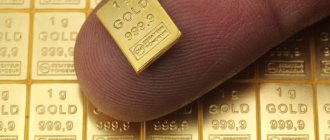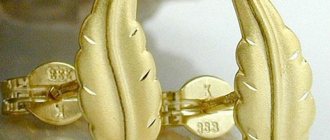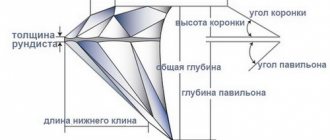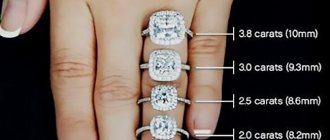In ancient times, grains of various plants were mainly used as units of mass for jewelry. Today we use more convenient designations, but even the word “carat” comes from the name of the carob tree, the seeds of which also served to determine the value of a stone or pearl.
♥ ON THE TOPIC: BelAZ-75710: 1,300 liters of fuel per 100 km and other 7 facts about the best dump truck in the world from Belarus.
What is a carat?
So, there is an international treaty called the Meter Convention, which has now been signed by 55 industrialized and trading nations. This agreement ensures the constancy and unity of measurement standards, including the carat, as a unit of measurement for the mass of a precious stone or pearl.
♥ ON THE TOPIC: BelAZ-75710: 1,300 liters of fuel per 100 km and other 7 facts about the best dump truck in the world from Belarus.
Units
Kilogram
In the SI system, mass is expressed in kilograms. The kilogram is determined based on the exact numerical value of Planck's constant h
, equal to 6.62607015×10⁻³⁴, expressed in J s, which is equal to kg m² s⁻¹, with the second and meter being determined by the exact values of
c
and Δ
ν
Cs. The mass of one liter of water can be approximately considered equal to one kilogram. The derivatives of kilogram, gram (1/1000 of a kilogram) and ton (1000 kilograms) are not SI units, but are widely used.
Electron-volt
Electronvolt is a unit for measuring energy. It is usually used in the theory of relativity, and energy is calculated using the formula E
=
mc²
, where
E
is energy,
m
is mass, and
c
is the speed of light.
According to the principle of equivalence of mass and energy, an electronvolt is also a unit of mass in the system of natural units, where c
is equal to one, which means mass equals energy. Electrovolts are mainly used in nuclear and atomic physics.
Atomic mass unit
Atomic mass unit ( a.u.m.
) is intended for masses of molecules, atoms, and other particles. One a. e.m. is equal to 1/12 the mass of a carbon nuclide atom, ¹²C. This is approximately 1.66 × 10 ⁻²⁷ kilograms.
Slug
Slugs are used primarily in the British Imperial system in Great Britain and some other countries. One slug is equal to the mass of a body that moves with an acceleration of one foot per second per second when a force of one pound-force is applied to it. This is approximately 14.59 kilograms.
The mass of the Sun is 1.9884×1030 kg
Solar mass
Solar mass is a measure of mass used in astronomy to measure stars, planets and galaxies. One solar mass is equal to the mass of the Sun, that is, 2 × 10³⁰ kilograms. The mass of the Earth is approximately 333,000 times less.
Carat
Carats measure the weight of precious stones and metals in jewelry. One carat is equal to 200 milligrams. The name and the size itself are associated with the seeds of the carob tree (in English: carob, pronounced “carob”). One carat used to be equal to the weight of the seed of this tree, and buyers carried their seeds with them to check whether they were being deceived by sellers of precious metals and stones. The weight of a gold coin in Ancient Rome was equal to 24 carob seeds, and therefore carats began to be used to indicate the amount of gold in the alloy. 24 karat is pure gold, 12 karat is half gold alloy, and so on.
Soft metric weight labeling on food products in Canada
Grand
The grain was used as a measure of weight in many countries before the Renaissance. It was based on the weight of grains, mainly barley, and other popular crops at the time. One grain is equal to about 65 milligrams. This is a little more than a quarter of a carat. Until carats became widespread, grains were used in jewelry. This measure of weight is still used to this day to measure the mass of gunpowder, bullets, arrows, and gold foil in dentistry.
Other units of mass
In countries where the metric system is not adopted, the British Imperial system is used. For example, in the UK, USA and Canada, pounds, stones and ounces are widely used. One pound is equal to 453.6 grams. Stones are used mainly only to measure human body weight. One stone is approximately 6.35 kilograms or exactly 14 pounds. Ounces are primarily used in cooking recipes, especially for foods in small portions. One ounce is 1/16 of a pound, or approximately 28.35 grams. In Canada, which formally adopted the metric system in the 1970s, many products are sold in rounded imperial units, such as one pound or 14 fluid ounces, but are labeled with weight or volume in metric units. In English, such a system is called “soft metric ”
), in contrast to the “hard metric” system (English
hard metric
), in which the rounded weight in metric units is indicated on the packaging. This image shows "soft metric" food packaging with weight in metric units only and volume in both metric and imperial units.
Bibliography
Author of the article: Kateryna Yuri
How much does 1 carat weigh when measuring the weight of gemstones?
According to the certificate, the carat weight is equivalent to 200 mg (0.2 grams). Moreover, in most countries (including Russia), the carat cannot have a fractional part, and the weight of the raw material or product is indicated by an integer.
♥ ON THE TOPIC: How brand names appeared: Ikea, Lego, Pepsi, Reebok, Skype, Sony, Canon, Google - 16 stories about the origin of the names of famous companies.
Various carats
Firstly, with this unit of measurement, some associated mass, others volume and area, and still others the purity (sample) of a substance. In Egypt, a carat was also called a unit of volume: 0.064 liters and a unit of area: 175 m2 .
Secondly, the carat associated with the weight measurement was itself different:
- The English carat differed slightly from the French and a little more from the Viennese, respectively - 205.30, 205.87 and 206.08 mg.
- Arabic carat – about 223 mg.
- A carat in Egypt, Mecca and Syria is 195 mg.
- Finally, since 1907, a metric carat has been 0.2 grams.
This is the modern generally accepted carat to gram ratio.
British karat gold is used to evaluate the purity of a precious metal. How many 24 parts of gold are in a sample - this is the sample. Thus, 14K gold corresponds to 583 purity (14/24 = 0.583), 18K – 750, 23 – 958. In most countries, the minimum purity level of gold is 9K, that is, 375 purity.
The abbreviated designation for the weight of precious stones in carats is ct (international), Russian - car.
Another measure of weight is also associated with the plant standard: gran, which means grain. The average weight of barley grain is 62.2 mg - one grain. This outdated unit of weight, used by jewelers and pharmacists, has been preserved in literary usage: not a grain of something means complete absence.
In the troy system, where the grain is the minimum unit of weight of precious metals, the troy ounce is usually used. At stock exchange trading, this is rather a tribute to tradition: no one converts ounces into drachms, scruples and grains, although modern electronic scales could easily cope with such a task.
The mite, the smallest coin, as a measure of something, was preserved thanks to the Bible in an allegorical sense: to make one’s mite, that is, to take part within one’s ability in some matter.
Obsolete carat
In the literature and scientific works of the past, you can also find the designations “English carat” and “Arabic carat” (also known as “Kirat”).
The English carat (about 205.4 grams) was used in Britain and its colonies until 1888 and was equal to approximately 3,170 troy grains, which in turn was equivalent to the weight of an average grain of barley.
The Arabic carat was defined differently in different countries of the Middle East and Asia. For example, in Egypt and Syria it was about 195 mg, and in Asia Minor - 204 mg.
♥ ON THE TOPIC: 70 interesting facts about IT technologies that you might not know.
Ounce
For trading on the stock exchange, the troy ounce is used, which is a fairly accurate measurement. It should not be confused with those previously outlined. A troy ounce corresponds only to pure gold, with a purity level of 999 or higher. It means the weight of the metal, and in accordance with this it helps to find out its price on the world market. By weight it is approximately 31.103 grams. If you purchase investment coins, bars, or a virtual amount of gold through a bank or exchange, you will encounter exactly this value, which is designated as ozt.
Carat in gold
Our compatriots are often confused by the fact that in many Western countries the fineness of gold is measured in carats. Indeed, how can you determine the ratio of metals in a product using a unit of weight?
In fact, it's simple. Just like the usual standard, carat determines the proportion of pure gold in the alloy, or rather, in its 24 weight parts. Converting a sample into carats is quite simple; you just need to multiply the existing value by 24 and then divide by 1000. For example, to convert the 585th sample into carats, we use a simple equation:
X = 24 × 585: 1000 = 14 carats (the 585th hallmark corresponds to 14 carats)
In a similar way, you can convert carats to fineness:
X = 1000 × 18: 24 = 750 hallmark (18 carats corresponds to 750 hallmark).
Several meanings of the term for a measure of luxury
A metric or diamond carat is a unit of measurement for the weight of gemstones equal to 200 mg. In the Russian Federation, the abbreviation “kar” is accepted, and the international designation is ct.
The unit characterizing the degree of purity of the gold alloy has a consonant name - carat. It is also called hallmark or gold, and is designated “K”. The standard is considered to be a 24-karat product. Thus, an ingot marked 12 K will consist of only half of gold, and 6 K - accordingly, a quarter.
In many countries (Russian Federation, France, Germany and other countries), instead of gold carat (K), a metric standard is used, which determines the percentage of gold in the alloy. For example, 999 fineness is equal to the 24 K standard. Such bars are used as state reserves, stored in domestic and foreign banks, and private storage facilities.
There is a separate unit for measuring the weight of pearls - gran. It is equal to ¼ carat (50 mg). In the Land of the Rising Sun, the weight of a pearl is measured as momme (3.75 g).
How did the measurement method come about?
The history of karat is quite old. It is believed that in ancient times there were no scales, and stones were sold based on the final weight. Therefore, it was necessary to compare the sizes of the stones, their weight and bring them into one measurement system.
It was for such purposes that carob (carob) grains were used. This tree grew on those continents where precious stones were mined. And in other countries a little later they began to use acacia grains to estimate weight. And yet, the carob was perfect for this role, since the grains were always the same size, regardless of the circumstances of the tree’s growth and its location. Since then, a similar-sounding name appeared, and gradually people began to learn about this unit.
It is worth noting that the official measure of weight for a gemstone, the “carat,” was adopted in 1907 by the Fourth General Conference on Weights and Measures. But in the Soviet Union it was recognized only in 1922. From that moment on, the weight measure became official and was used to measure the weight of all precious stones. However, some people mistakenly believe that carat indicates the size of the stone. And to the question “what is the size of the stone?” it is impossible to answer with only a weight designation.
In fact, the size of a 1 carat jewel can vary depending on the density of the stone. Crystals with this weight will appear larger than minerals, so a carat diamond will be slightly smaller than a topaz or emerald.
A stone is also assigned to a certain category based on its carat content. For example, this practice is applied to diamonds. Jewelry is classified into different groups based on the number of carats, and, accordingly, the cost of each group of stones is different.
What should you pay attention to?
Purchasing gold in karats with a high purity index will be the most sensible investment. If necessary, you can sell a ring or chain at a higher price, since the price of gold has not fallen for many years.
On the other hand, for those who value primarily the aesthetic component, without intending to invest money in jewelry, numerous alloys may be suitable. The use of non-ferrous metal will allow you to create uniquely beautiful floral or fantasy compositions.
The strength of the alloys will allow you to make the finest cuts of the product and decorate it with filigree carvings. Pairing rose or herbal gold with a similar gemstone tone looks quite beautiful. In any case, when purchasing an item from a jeweler, find out about the content of precious metals, the quality of the stones, the percentage of pure gold content, and the components of the alloy. This way you will be sure that you did not make a mistake with your purchase.
How many grams in one carat
At the beginning of the 20th century, jewelers agreed on the exact number of grams in a carat. In 1907, they decided to equate the weight of one carat to 0.2 grams. However, not all countries agreed to convert the mass into carats, continuing to use their own values. The countries adopted a unified standard in the following sequence:
- France - 1907
- Holland - 1911
- USA - 1913
- USSR - 1923
Following these states, other countries also decided to convert grams to carats. However, a 1 ct gem is a rare and expensive stone. Much more often you come across crystals with a smaller mass, not reaching 0.2 grams. But here, too, jewelers did not use standard measures and created their own unit - the point. It has been established that one ct (0.2 grams) is equal to 100 points.











